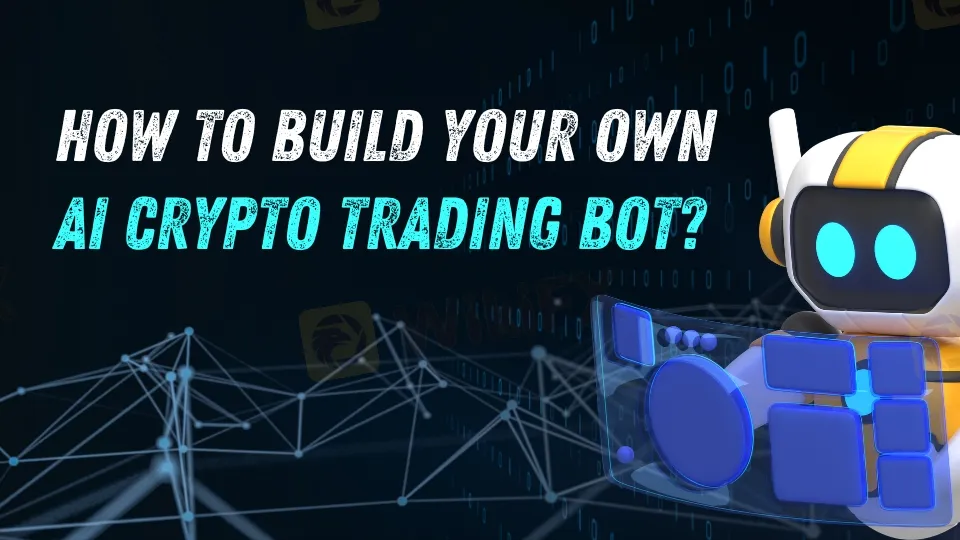简体中文
繁體中文
English
Pусский
日本語
ภาษาไทย
Tiếng Việt
Bahasa Indonesia
Español
हिन्दी
Filippiiniläinen
Français
Deutsch
Português
Türkçe
한국어
العربية
How to Build Your Own AI Crypto Trading Bot?
Abstract:Step-by-step guide on how to build your own AI crypto trading bot. Learn programming, API setup, trading strategies, deployment, and bot optimization for success.

The cryptocurrency trading landscape is rapidly evolving due to the transformative power of artificial intelligence (AI). A growing number of traders are adopting AI-driven automation to enhance their trading efficiency and effectiveness. AI-powered crypto trading bots can operate 24/7, without emotional interference, and analyze large volumes of data at a pace beyond human capability. If youve ever considered creating your own AI crypto trading bot, this guide will provide the detailed steps and insights needed to guide you toward success.
In this comprehensive article, you‘ll learn how to choose the right programming tools, develop effective trading strategies, and deploy your bot in real-time trading environments. By the end, you’ll have a solid understanding of how to build an AI crypto trading bot that automates your trading process and elevates your cryptocurrency trading game.
What Are AI-Powered Crypto Trading Bots?
AI-powered crypto trading bots are advanced software programs designed to automate the buying and selling of cryptocurrencies by leveraging artificial intelligence and machine learning algorithms. These bots process and analyze large amounts of market data, identify trends, and execute trades based on predefined strategies or adaptive learning. Integrating AI into crypto trading offers a cutting-edge approach in the fast-paced, volatile world of cryptocurrency trading.
One of the biggest advantages of using AI bots is their ability to continuously learn and adapt. By analyzing historical and real-time data, these bots adjust their strategies to the markets ever-changing conditions. This adaptability allows traders to capture profitable opportunities and mitigate risks, leading to more consistent returns over time.
Step-by-Step Guide to Building Your AI Crypto Trading Bot
1. Choose the Right Programming Language
The first step in building your AI crypto trading bot is selecting a suitable programming language. Your decision will depend on your technical expertise, the complexity of your bot, and the specific functionalities you need. Below are some common programming languages used for AI crypto bots:
- Python: This is a popular choice for AI development due to its simplicity, readability, and extensive library support for data analysis, machine learning, and automation. While Python may have slightly slower execution times compared to lower-level languages, it remains highly favored for crypto bots thanks to its ease of use and community support.
- JavaScript: JavaScript is versatile and widely used in web development, making it ideal for bots that interact with web-based cryptocurrency exchanges. Its asynchronous nature enables it to handle multiple API requests efficiently. However, it may not be as effective for heavy data processing or computational tasks.
- C#: Known for high performance and efficient memory management, C# is often used in more complex trading systems that require real-time data processing. Though it offers speed and power, the language has a steeper learning curve compared to Python.
- Rust and Go (Golang): These languages are praised for their speed and efficiency, which make them suitable for high-frequency trading bots. Rust emphasizes memory safety, while Go excels in handling concurrent processes, which can be useful for bots managing large data streams.
When choosing a programming language, consider factors like rapid execution, API integration, and familiarity with the language. Each language has its own strengths depending on the bot's specific requirements.
2. Set Up API Connections for Cryptocurrency Exchanges
Once you‘ve selected your programming language, the next step is establishing API connections to cryptocurrency exchanges. These APIs enable your bot to interact with the exchange’s server to retrieve market data, place trades, and manage account information in real-time.
Leading exchanges like Binance, Coinbase, and Kraken provide accessible APIs with functionalities that allow bots to execute market or limit orders, check account balances, and receive real-time market data. Security is crucial here—ensure your API keys are protected and set with appropriate permissions to avoid unauthorized access or withdrawals.

Heres an example of how to connect to the Binance API using the python-binance library:
From binance.client import Client
api_key = 'your_api_key_here'
api_secret = 'your_api_secret_here'
client = Client(api_key, api_secret)
# Fetch account information
account_info = client.get_account()
print(account_info)
Make sure to start by testing your bot in a sandbox or testnet environment (such as Binances Testnet) to avoid real financial risks during the initial development and testing phases.
3. Develop and Test Your AI Trading Strategy
The trading strategy is the core of your AI crypto trading bot. It dictates the bot‘s behavior in response to market movements, determining when it buys, sells, or holds assets. A well-crafted strategy is essential to the bot’s success. Below are some common AI-based trading strategies:
- Trend Following: This strategy involves the bot recognizing market trends and executing trades that align with the overall trend direction (e.g., buying during an uptrend and selling during a downtrend).
- Arbitrage: Arbitrage bots capitalize on price differences between cryptocurrency exchanges by buying on one exchange and selling on another. This strategy demands fast execution and frequent trades to profit from slight price discrepancies.
- Market Making: In market making, the bot places both buy and sell orders at various price levels, profiting from the spread between the bid and ask prices. This strategy generates small but consistent gains through frequent trades.
Once your strategy is in place, backtesting is critical. Backtesting involves running your bot against historical market data to assess how it would have performed under past conditions. Platforms like Bitsgap and Gainium offer powerful backtesting tools that provide valuable insights and metrics, allowing you to fine-tune your bots performance.
Deploying and Optimizing Your AI Crypto Trading Bot
Once development and testing are complete, the next step is deploying your AI crypto trading bot. To ensure continuous operation, deploying the bot on cloud-based infrastructure like AWS, Google Cloud, or Microsoft Azure is recommended. These platforms offer scalable and reliable environments to run your bot around the clock, minimizing downtime and allowing it to seize trading opportunities at any time.
After your bot is live, ongoing monitoring and optimization are crucial. Cryptocurrency markets are dynamic, so your bots performance may fluctuate based on market conditions. Regularly reviewing trades, tweaking strategies, and incorporating technical analysis tools like TradingView indicators will help ensure your bot remains profitable over time.
Summary
Building your own AI-powered crypto trading bot offers an exciting opportunity to combine cutting-edge technology with advanced trading strategies. From choosing the right programming language to setting up secure API connections, designing effective trading strategies, and deploying your bot on cloud infrastructure, each step is critical to developing a successful AI-driven trading system. With thorough testing, continuous optimization, and careful monitoring, your bot can automate trading and unlock new profitable opportunities without constant supervision.

Disclaimer:
The views in this article only represent the author's personal views, and do not constitute investment advice on this platform. This platform does not guarantee the accuracy, completeness and timeliness of the information in the article, and will not be liable for any loss caused by the use of or reliance on the information in the article.
Read more

Seacrest Markets Exposed: Are You Facing Payout Denials and Spread Issues with This Prop Firm?
Seacrest Markets has garnered wrath from traders owing to a variety of reasons, including payout denials for traders winning trading challenges, high slippage causing losses, the lack of response from the customer support official to address withdrawal issues, and more. Irritated by these trading inefficiencies, a lot of traders have given a negative review of Seacrest Markets prop firm. In this article, we have shared some of them. Take a look!

GKFX Review: Are Traders Facing Slippage and Account Freeze Issues?
Witnessing capital losses despite tall investment return assurances by GKFX officials? Do these officials sound too difficult for you to judge, whether they offer real or fake advice? Do you encounter slippage issues causing a profit reduction on the GKFX login? Is account freezing usual at GKFX? Does the United Kingdom-based forex broker prevent you from accessing withdrawals? You are not alone! In this GKFX review guide, we have shared the complaints. Take a look!

Is Seaprimecapitals Regulated? A Complete Look at Its Safety and How It Works
The straightforward answer to this important question is no. Seaprimecapitals works as a broker without proper regulation. This fact is the most important thing any trader needs to know, because it creates serious risks for your capital and how safely the company operates. While this broker offers some good features, like the popular MetaTrader 5 platform and a low starting deposit, these benefits cannot make up for the major risks that come from having no real financial supervision. This article will give you a detailed, fact-based look at Seaprimecapitals regulation, what the company claims to do, the services it provides, and the clear differences between official information and user reviews. Our purpose is to give you the information you need to make a smart decision about the risks and benefits of working with this company.

Major Complaints of MUFG Broker in 2025 You Shouldn’t Ignore
2025 is about to end, and if you still want to be a trader or investor and are looking for a broker to invest with. It is important to read real user complaints first. This will help you understand the kind of problems users are facing with MUFG broker. In this article, we will tell you about the major complaints users have reported about MUFG in 2025, so you know what to watch out for. Do not ignore this MUFG broker article and understand the problems.
WikiFX Broker
Latest News
CQG Partners with Webull Singapore to Power the Broker’s New Futures Trading Offering
【WikiEXPO Global Expert Interviews】Ashish Kumar Singh: Building a Responsible and Interoperable Web3
IEXS Review 2025: A Complete Expert Analysis
CySEC Flags 21 Unauthorized Broker Websites in 2025 Crackdown
IEXS Regulation: A Complete Guide to Its Licenses and Safety Warnings
WinproFx Withdrawal Problems: A Complete Look at Delays and User Reports
Does WealthFX Generate Wealth or Losses for Traders? Find Out in This Review
FONDEX Review: Do Traders Really Face Inflated Spreads & Withdrawal Issues?
FXPrimus Review: Is FXPrimus Regulated and Reliable for 2025?
Simulated Trading Competition Experience Sharing
Currency Calculator



